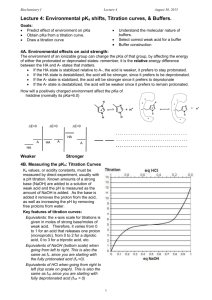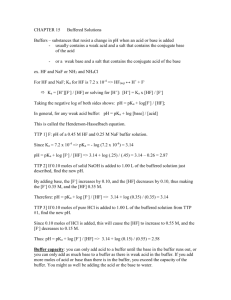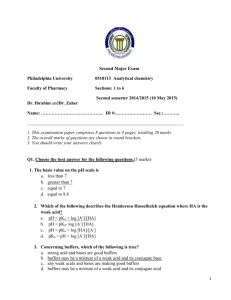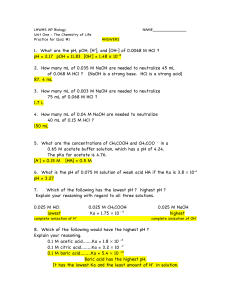lec04 _2013 - Andrew.cmu.edu
advertisement
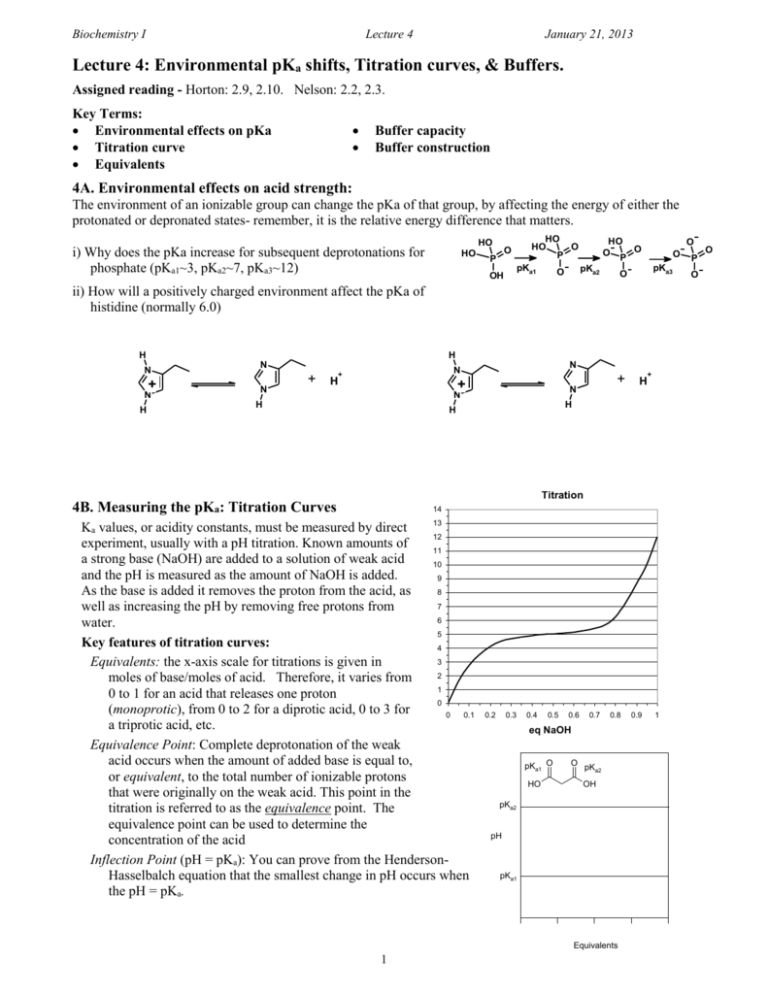
Biochemistry I Lecture 4 January 21, 2013 Lecture 4: Environmental pKa shifts, Titration curves, & Buffers. Assigned reading - Horton: 2.9, 2.10. Nelson: 2.2, 2.3. Key Terms: Environmental effects on pKa Titration curve Equivalents Buffer capacity Buffer construction 4A. Environmental effects on acid strength: The environment of an ionizable group can change the pKa of that group, by affecting the energy of either the protonated or depronated states- remember, it is the relative energy difference that matters. HO i) Why does the pKa increase for subsequent deprotonations for phosphate (pKa1~3, pKa2~7, pKa3~12) HO HO O HO P O P pKa1 OH HO O P O pKa2 O O O pKa3 O ii) How will a positively charged environment affect the pKa of histidine (normally 6.0) H H N + N H N N + N N + H + N H + N + H H H Titration 4B. Measuring the pKa: Titration Curves 14 13 Ka values, or acidity constants, must be measured by direct 12 experiment, usually with a pH titration. Known amounts of 11 a strong base (NaOH) are added to a solution of weak acid 10 and the pH is measured as the amount of NaOH is added. 9 As the base is added it removes the proton from the acid, as 8 7 well as increasing the pH by removing free protons from 6 water. 5 Key features of titration curves: 4 3 Equivalents: the x-axis scale for titrations is given in 2 moles of base/moles of acid. Therefore, it varies from 1 0 to 1 for an acid that releases one proton 0 (monoprotic), from 0 to 2 for a diprotic acid, 0 to 3 for 0 0.1 a triprotic acid, etc. Equivalence Point: Complete deprotonation of the weak acid occurs when the amount of added base is equal to, or equivalent, to the total number of ionizable protons that were originally on the weak acid. This point in the titration is referred to as the equivalence point. The equivalence point can be used to determine the concentration of the acid Inflection Point (pH = pKa): You can prove from the HendersonHasselbalch equation that the smallest change in pH occurs when the pH = pKa. 0.2 0.3 0.4 0.5 0.6 0.7 0.8 eq NaOH pKa1 O HO O pK a2 OH pKa2 pH pKa1 Equivalents 1 0.9 1 P O O Biochemistry I Lecture 4 January 21, 2013 4C. Buffers: A pH buffer is an acid that resists changes in the solution pH by absorbing or releasing protons. Buffers play an important role in cellular processes because they maintain the pH at an optimal level for biological processes. They are also widely used to control pH in laboratory processes. Titration 14 13 13 12 12 11 11 10 10 9 9 8 8 7 7 6 6 5 5 4 4 3 3 2 2 1 1 0 0 pH 14 0 0.2 0.4 0.6 0.8 1 0 0.1 0.2 0.3 0.4 0.5 0.6 0.7 0.8 0.9 eq NaOH Fraction Protonated Buffering range: Buffering capacity: 4D. Steps in Making a Buffer of concentration [AT]: [ A ] Goal: pH pK A log Method: [ HA] 1. Select a weak acid whose pKa is within one pH unit of the desired pH. 2. Determine the fraction protonated and deprotonated at the desired pH, fHA & fA3. Obtain this ratio of [HA] to [A-] by one of the following three methods: 1 i) Mix the indicated concentration of the weak acid and its conjugate base (e.g. sodium salt) to give the desired pH: [HA]= fHA [AT] [AT]=[HA]+[A-] [A-]= fA- [AT] ii) Use [AT] amount of the acid form of the weak acid and add sufficient strong base (e.g. NaOH) to make the required concentration of [A-] to attain the desired pH. The added base converts HA to A-. The amount of strong base to add is fA- equivalents, or a total of fA- [AT]. You are titrating starting from the left side. iii) Use [AT] amount of the conjugate base form of the weak acid and add sufficient strong acid (e.g. HCl) to make the required concentration of [HA] to attain the desired pH. The added acid converts A- to HA. The amount of strong acid to add is fHA equivalents, or a total of fHA [AT]. 1 In practice, the number of moles of NaOH or HCl is not directly measured, rather a pH electrode is used to monitor the pH of the solution, and sufficient NaOH or HCl is added until the desired pH is reached. 2 1 Biochemistry I Example: Buffer Histidine Pyruvic Acid Lecture 4 January 21, 2013 Make 1L of 1 M buffer solution at pH 5.0 using one of the following two buffers. 1. Which buffer would you use and why? pKa Approx. MW 6.0 (sidechain) 2.50 155 g/mol 110 g/mol 2. Determine fraction protonated and deprotonated at the desired pH R 10 ( pH pKa ) 1 f HA 1 R pH titration f A R 1 R 9 8 7 pH 6 5 4 3 3. Obtain the desired ration of [HA] and [A-] i) Mixing the appropriate amount of the acid and base form of the buffering acid. 2 1 0 0 0.1 0.2 0.3 0.4 0.5 0.6 0.7 0.8 0.9 1 Equivalents pH titration 9 8 7 6 pH ii) Starting with the pure weak acid., HA, add fA- equivalents of a strong base, or fA- [AT] moles of the strong base. 5 4 3 2 1 0 0 0.1 0.2 0.3 0.4 0.5 0.6 0.7 0.8 0.9 1 Equivalents pH titration iii) Starting with the pure sodium salt, NaA, add fHA equivalents of a strong acid, or fAH [AT] moles of the strong acid. 9 8 7 pH 6 5 4 3 2 1 0 0 0.1 0.2 0.3 0.4 0.5 0.6 0.7 0.8 0.9 Equivalents 3 1 Biochemistry I Lecture 4 January 21, 2013 Polyprotic Buffers: 1. Select weak acid based on any of its pKa values. 2. Use pKa closest to desired pH to calculate fHA and fA-. 3. i) Use chemical forms of “(HA)” and “(A-)” that represent the species present at the pKa you choose, e.g. NaH2PO4/Na2HPO4 if the middle ionization was used. ii) Starting from completely protonated form (e.g. H3PO4). Add sufficient whole equivalents (n) to reach the buffer region you are using, add (n + fA-) equivalents of strong base, or (n + fA-) [AT] moles of strong base. iii) Starting from completely ionized form (e.g. Na3PO4). Add sufficient whole equivalents (n) to reach the buffer region you are using, add (n + fAH) equivalents of acid, or (n + fAH) [AT] moles of strong acid. Practice: 1. Assume that the histidine containing protein also contains a group that ionizes with a pKa of 4, draw the curve of fraction protonated versus pH for that group on the same graph. The curve for the histidine is already plotted for you. N + N H 2. Which region of the plot corresponds to both groups being fully deprotonated. Fraction Protonated H 1 0.9 0.8 0.7 0.6 0.5 0.4 0.3 0.2 0.1 0 0 1 2 3 4 5 6 7 8 9 10 11 12 pH 4 O OH


